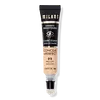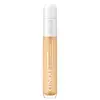Milani Conceal & Perfect Face Lift Collection Undereye Brightener Versus Clinique Even Better All Over Concealer + Eraser
What's inside
What's inside
 Key Ingredients
Key Ingredients

 Benefits
Benefits

 Concerns
Concerns

 Ingredients Side-by-side
Ingredients Side-by-side

Water
Skin ConditioningDimethicone
EmollientC13-14 Alkane
SolventPhenyl Trimethicone
Skin ConditioningGlycerin
HumectantButylene Glycol
HumectantDiethylhexyl Carbonate
EmollientCetyl PEG/PPG-10/1 Dimethicone
EmulsifyingPentylene Glycol
Skin ConditioningMica
Cosmetic ColorantPhenoxyethanol
PreservativeEthylhexylglycerin
Skin ConditioningTocopherol
AntioxidantMagnesium Sulfate
Triethoxycaprylylsilane
Disteardimonium Hectorite
StabilisingSorbitan Sesquioleate
EmulsifyingPentaerythrityl Tetra-Di-T-Butyl Hydroxyhydrocinnamate
AntioxidantSilica
AbrasiveVinyl Dimethicone/Methicone Silsesquioxane Crosspolymer
Stearoyl Inulin
EmollientDimethicone/Vinyl Dimethicone Crosspolymer
Skin ConditioningTrimethylsiloxysilicate
EmollientDisodium EDTA
Caffeine
Skin ConditioningSodium Hyaluronate
HumectantNiacinamide
Smoothing3-O-Ethyl Ascorbic Acid
Skin ConditioningCurcuma Longa Root Extract
MaskingCollagen
MoisturisingLeuconostoc/Radish Root Ferment Filtrate
AntimicrobialPanax Ginseng Root Extract
EmollientCitrus Aurantium Dulcis Fruit Extract
MaskingCitrus Aurantium Dulcis Flower Extract
Skin ConditioningEthyl Hexanediol
Solvent1,2-Hexanediol
Skin ConditioningCI 77891
Cosmetic ColorantIron Oxides
Water, Dimethicone, C13-14 Alkane, Phenyl Trimethicone, Glycerin, Butylene Glycol, Diethylhexyl Carbonate, Cetyl PEG/PPG-10/1 Dimethicone, Pentylene Glycol, Mica, Phenoxyethanol, Ethylhexylglycerin, Tocopherol, Magnesium Sulfate, Triethoxycaprylylsilane, Disteardimonium Hectorite, Sorbitan Sesquioleate, Pentaerythrityl Tetra-Di-T-Butyl Hydroxyhydrocinnamate, Silica, Vinyl Dimethicone/Methicone Silsesquioxane Crosspolymer, Stearoyl Inulin, Dimethicone/Vinyl Dimethicone Crosspolymer, Trimethylsiloxysilicate, Disodium EDTA, Caffeine, Sodium Hyaluronate, Niacinamide, 3-O-Ethyl Ascorbic Acid, Curcuma Longa Root Extract, Collagen, Leuconostoc/Radish Root Ferment Filtrate, Panax Ginseng Root Extract, Citrus Aurantium Dulcis Fruit Extract, Citrus Aurantium Dulcis Flower Extract, Ethyl Hexanediol, 1,2-Hexanediol, CI 77891, Iron Oxides
Water
Skin ConditioningMethyl Trimethicone
Skin ConditioningTrimethylsiloxysilicate
EmollientDimethicone
EmollientButylene Glycol
HumectantPhenyl Trimethicone
Skin ConditioningNeopentyl Glycol Diheptanoate
EmollientNiacinamide
SmoothingHydroxyethyl Urea
HumectantLauryl PEG-9 Polydimethylsiloxyethyl Dimethicone
Skin ConditioningGlycerin
HumectantSodium Polyaspartate
HumectantAscorbyl Glucoside
AntioxidantCaffeine
Skin ConditioningPhytosphingosine
Skin ConditioningMagnesium Ascorbyl Phosphate
AntioxidantResveratrol
AntioxidantSodium Hyaluronate
HumectantPolygonum Cuspidatum Root Extract
AntioxidantAcetyl Hexapeptide-8
HumectantPalmitoyl Hexapeptide-12
Skin ConditioningTocopheryl Acetate
AntioxidantTetrahexyldecyl Ascorbate
AntioxidantSalicylic Acid
MaskingSigesbeckia Orientalis Extract
Skin ConditioningCaprylyl Glycol
EmollientTrihydroxystearin
Skin ConditioningTriethyl Citrate
MaskingPPG-15 Stearyl Ether
EmollientPEG-10 Dimethicone
Skin ConditioningSorbitol
HumectantTrehalose
HumectantMicrococcus Lysate
Skin ConditioningIsopropyl Isostearate
EmollientLecithin
EmollientZinc Stearate
Cosmetic ColorantDimethicone/PEG-10/15 Crosspolymer
Alumina
AbrasiveTriethoxycaprylylsilane
Silica
AbrasiveGlyceryl Polymethacrylate
Laureth-7
EmulsifyingMagnesium Aluminum Silicate
AbsorbentHexylene Glycol
EmulsifyingPEG-8
HumectantDisteardimonium Hectorite
StabilisingPropylene Glycol Caprylate
Skin ConditioningVinyl Dimethicone/Methicone Silsesquioxane Crosspolymer
Polysilicone-11
Sodium Hydroxide
BufferingXanthan Gum
EmulsifyingSodium Chloride
MaskingCitric Acid
BufferingAmmonium Acryloyldimethyltaurate/Vp Copolymer
Dipropylene Glycol
HumectantBHT
AntioxidantDisodium EDTA
Sodium Citrate
BufferingPotassium Sorbate
PreservativePhenoxyethanol
PreservativeMica
Cosmetic ColorantCI 77891
Cosmetic ColorantCI 77491
Cosmetic ColorantCI 77492
Cosmetic ColorantCI 77499
Cosmetic ColorantCI 77163
Cosmetic ColorantWater, Methyl Trimethicone, Trimethylsiloxysilicate, Dimethicone, Butylene Glycol, Phenyl Trimethicone, Neopentyl Glycol Diheptanoate, Niacinamide, Hydroxyethyl Urea, Lauryl PEG-9 Polydimethylsiloxyethyl Dimethicone, Glycerin, Sodium Polyaspartate, Ascorbyl Glucoside, Caffeine, Phytosphingosine, Magnesium Ascorbyl Phosphate, Resveratrol, Sodium Hyaluronate, Polygonum Cuspidatum Root Extract, Acetyl Hexapeptide-8, Palmitoyl Hexapeptide-12, Tocopheryl Acetate, Tetrahexyldecyl Ascorbate, Salicylic Acid, Sigesbeckia Orientalis Extract, Caprylyl Glycol, Trihydroxystearin, Triethyl Citrate, PPG-15 Stearyl Ether, PEG-10 Dimethicone, Sorbitol, Trehalose, Micrococcus Lysate, Isopropyl Isostearate, Lecithin, Zinc Stearate, Dimethicone/PEG-10/15 Crosspolymer, Alumina, Triethoxycaprylylsilane, Silica, Glyceryl Polymethacrylate, Laureth-7, Magnesium Aluminum Silicate, Hexylene Glycol, PEG-8, Disteardimonium Hectorite, Propylene Glycol Caprylate, Vinyl Dimethicone/Methicone Silsesquioxane Crosspolymer, Polysilicone-11, Sodium Hydroxide, Xanthan Gum, Sodium Chloride, Citric Acid, Ammonium Acryloyldimethyltaurate/Vp Copolymer, Dipropylene Glycol, BHT, Disodium EDTA, Sodium Citrate, Potassium Sorbate, Phenoxyethanol, Mica, CI 77891, CI 77491, CI 77492, CI 77499, CI 77163
Ingredients Explained
These ingredients are found in both products.
Ingredients higher up in an ingredient list are typically present in a larger amount.
Butylene Glycol (or BG) is used within cosmetic products for a few different reasons:
Overall, Butylene Glycol is a safe and well-rounded ingredient that works well with other ingredients.
Though this ingredient works well with most skin types, some people with sensitive skin may experience a reaction such as allergic rashes, closed comedones, or itchiness.
Learn more about Butylene GlycolCaffeine is most associated with coffee, tea, and cacao. In skincare, it helps with calming inflammation and is rich in antioxidants.
While caffeine is used to treat cellulite and and dark circles, further studies are needed to prove this. It has been believed to help with these skin conditions due to its ability to dilate blood vessels and increase blood flow.
Some studies are looking into caffeine's ability to protect against UV rays.
Learn more about CaffeineCi 77891 is a white pigment from Titanium dioxide. It is naturally found in minerals such as rutile and ilmenite.
It's main function is to add a white color to cosmetics. It can also be mixed with other colors to create different shades.
Ci 77891 is commonly found in sunscreens due to its ability to block UV rays.
Learn more about CI 77891Dimethicone is a type of synthetic silicone created from natural materials such as quartz.
What it does:
Dimethicone comes in different viscosities:
Depending on the viscosity, dimethicone has different properties.
Ingredients lists don't always show which type is used, so we recommend reaching out to the brand if you have questions about the viscosity.
This ingredient is unlikely to cause irritation because it does not get absorbed into skin. However, people with silicone allergies should be careful about using this ingredient.
Note: Dimethicone may contribute to pilling. This is because it is not oil or water soluble, so pilling may occur when layered with products. When mixed with heavy oils in a formula, the outcome is also quite greasy.
Learn more about DimethiconeDisodium EDTA plays a role in making products more stable by aiding other preservatives.
It is a chelating agent, meaning it neutralizes metal ions that may be found in a product.
Disodium EDTA is a salt of edetic acid and is found to be safe in cosmetic ingredients.
Learn more about Disodium EDTADisteardimonium Hectorite comes from the clay mineral named hectorite. It is used to add thickness to a product.
It can also help stabilize a product by helping to disperse other ingredients.
Hectorite is a rare, white clay mineral.
Learn more about Disteardimonium HectoriteGlycerin is already naturally found in your skin. It helps moisturize and protect your skin.
A study from 2016 found glycerin to be more effective as a humectant than AHAs and hyaluronic acid.
As a humectant, it helps the skin stay hydrated by pulling moisture to your skin. The low molecular weight of glycerin allows it to pull moisture into the deeper layers of your skin.
Hydrated skin improves your skin barrier; Your skin barrier helps protect against irritants and bacteria.
Glycerin has also been found to have antimicrobial and antiviral properties. Due to these properties, glycerin is often used in wound and burn treatments.
In cosmetics, glycerin is usually derived from plants such as soybean or palm. However, it can also be sourced from animals, such as tallow or animal fat.
This ingredient is organic, colorless, odorless, and non-toxic.
Glycerin is the name for this ingredient in American English. British English uses Glycerol/Glycerine.
Learn more about GlycerinMica is a naturally occurring mineral used to add shimmer and color in cosmetics. It can also help improve the texture of a product or give it an opaque, white/silver color.
Serecite is the name for very fine but ragged grains of mica.
This ingredient is often coated with metal oxides like titanium dioxide. Trace amounts of heavy metals may be found in mica, but these metals are not harmful in our personal products.
Mica has been used since prehistoric times throughout the world. Ancient Egyptian, Indian, Greek, Roman, Aztec, and Chinese civilizations have used mica.
Learn more about MicaNiacinamide is a multitasking form of vitamin B3 that strengthens the skin barrier, reduces pores and dark spots, regulates oil, and improves signs of aging.
And the best part? It's gentle and well-tolerated by most skin types, including sensitive and reactive skin.
You might have heard of "niacin flush", or the reddening of skin that causes itchiness. Niacinamide has not been found to cause this.
In very rare cases, some individuals may not be able to tolerate niacinamide at all or experience an allergic reaction to it.
If you are experiencing flaking, irritation, and dryness with this ingredient, be sure to double check all your products as this ingredient can be found in all categories of skincare.
When incorporating niacinamide into your routine, look out for concentration amounts. Typically, 5% niacinamide provides benefits such as fading dark spots. However, if you have sensitive skin, it is better to begin with a smaller concentration.
When you apply niacinamide to your skin, your body converts it into nicotinamide adenine dinucleotide (NAD). NAD is an essential coenzyme that is already found in your cells as "fuel" and powers countless biological processes.
In your skin, NAD helps repair cell damage, produce new healthy cells, support collagen production, strengthen the skin barrier, and fight environmental stressors (like UV and pollution).
Our natural NAD levels start to decline with age, leading to slower skin repair, visible aging, and a weaker skin barrier. By providing your skin niacinamide, you're recharging your skin's NAD levels. This leads to stronger, healthier, and younger looking skin.
Another name for vitamin B3 is nicotinamide. This vitamin is water-soluble and our bodies don't store it. We obtain Vitamin B3 from either food or skincare. Meat, fish, wheat, yeast, and leafy greens contain vitamin B3.
The type of niacinamide used in skincare is synthetically created.
Learn more about NiacinamidePhenoxyethanol is a preservative that has germicide, antimicrobial, and aromatic properties. Studies show that phenoxyethanol can prevent microbial growth. By itself, it has a scent that is similar to that of a rose.
It's often used in formulations along with Caprylyl Glycol to preserve the shelf life of products.
Phenyl Trimethicone is a silicon-based polymer. It is derived from silica.
Phenyl Trimethicone is used as an emollient and prevents products from foaming.
As an emollient, it helps trap moisture in the skin. It is considered an occlusive.
Learn more about Phenyl TrimethiconeSilica, also known as silicon dioxide, is a naturally occurring mineral. It is used as a fine, spherical, and porous powder in cosmetics.
Though it has exfoliant properties, the function of silica varies depending on the product.
The unique structure of silica enhances the spreadability and adds smoothness, making it a great texture enhancer.
It is also used as an active carrier, emulsifier, and mattifier due to its ability to absorb excess oil.
In some products, tiny microneedles called spicules are made from silica or hydrolyzed sponge. When you rub them in, they lightly polish away dead skin layers and enhance the penetration of active ingredients.
Learn more about SilicaSodium Hyaluronate is hyaluronic acid's salt form. It is commonly derived from the sodium salt of hyaluronic acid.
Like hyaluronic acid, it is great at holding water and acts as a humectant. This makes it a great skin hydrating ingredient.
Sodium Hyaluronate is naturally occurring in our bodies and is mostly found in eye fluid and joints.
These are some other common types of Hyaluronic Acid:
Learn more about Sodium HyaluronateTriethoxycaprylylsilane is a silicone used to bind and stabilize ingredients.
As an emulsifier, it helps prevent ingredients from separating. This can help elongate the shelf life of products.
Triethoxycaprylylsilane is often used to coat mineral sunscreens ingredients to help give a better feel. It also helps reduce oxidative stress in sunscreens.
Learn more about TriethoxycaprylylsilaneThis silicone is an emollient. Emollients create a thin film on the skin to prevent moisture from escaping.
It is not soluble in water and helps increase water-resistance in products.
According to a manufacturer, it can blend seamlessly with silicone oils, such as Cyclopentasiloxane.
Learn more about TrimethylsiloxysilicateThis ingredient is used in makeup and skincare to thicken formulas, reduce shine, and give skin a silky-smooth feel.
It’s a white silicone powder that sits in fine lines and pores to blur their appearance though its effectiveness depends on the particle size.
You'll typically find this ingredient in amounts between 0.1-20%.
Learn more about Vinyl Dimethicone/Methicone Silsesquioxane CrosspolymerWater. It's the most common cosmetic ingredient of all. You'll usually see it at the top of ingredient lists, meaning that it makes up the largest part of the product.
So why is it so popular? Water most often acts as a solvent - this means that it helps dissolve other ingredients into the formulation.
You'll also recognize water as that liquid we all need to stay alive. If you see this, drink a glass of water. Stay hydrated!
Learn more about Water